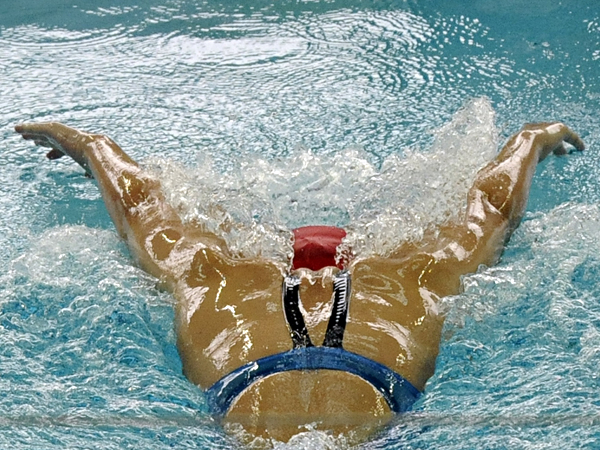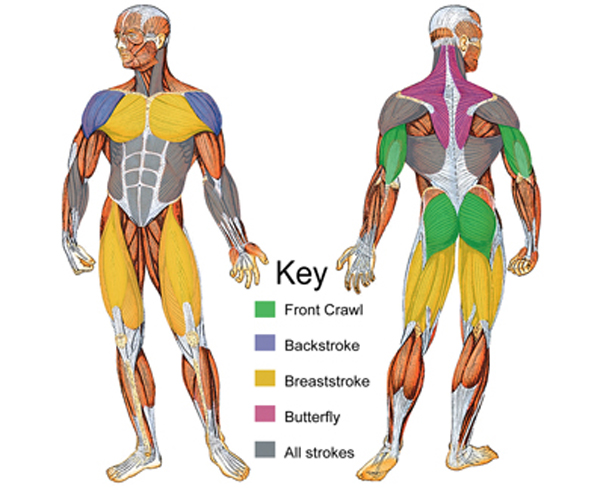What muscle groups does swimming develop and its benefits

File Photo Credit: Wong Chek Poh/SportSG
By Malcolm Baey
Swimming is a low-impact sport that incorporates a wide range of muscle groups and most muscles in the body are worked in different ways. Because of this, risk of injury is very low and the benefits are numerous. When stroke techniques are executed properly, the muscles lengthen and increase in flexibility. This is why most competitive swimmers have broader shoulders and extremely toned physiques.
Muscles developed by swimming
Although each stroke uses different muscle groups to execute different techniques, all swimming strokes will develop the following muscles:- Core abdominal and lower back muscles that keep the body steady in streamlined positions in the water to reduce drag.
- Deltoid and shoulder muscles to help the hands have proper entry in the water and to reach out far.
- Forearm muscles that are worked when pulling in the water for more propulsion.
- Upper back muscles that stabilise the shoulders throughout the swimming strokes.
- Glutes and hamstring muscles to keep the body in a balanced position and to aid in propulsion.

Photo credit: swimtoslim.com
Muscle groups engaged by Freestyle and Backstroke
- Core abdominal and obliques are important in rotating the torso for a longer stroke.
- Hip flexors are used to maintain a compact and steady kick.
Arm: Thenars (hand muscle), brachioradialis (forearm flex muscle), flexor digitorum profundus (forearm extend muscle), biceps, triceps, deltoids (shoulder muscle)
Neck: sternocleidomastoid (neck muscle)
Trunk: pectoralis, serratus anterior (side muscles), external oblique (outer ab muscles), rectus abdominus (abs), latissimus dorsi (back muscle), trapezius, spinus erectus (muscles that support your spine), teres major, teres minor, rhomboid major, rhomboid minor (all of these "major and minor" muscles help make up the shoulder muscles), gluteus maximus (rear-end muscles), abductor magnus (groin)
Leg: quadriceps, hamstrings, gastrocnemius (calf muscle), tibialis anterior (shin muscle), flexor digitorum brevis (foot muscles)
Muscle groups engaged by Butterfly stroke
- Core abdominal and lower back muscles lift the body out of the water when breathing.
- Glutes ensure the legs move as one like a dolphin or mermaid.
- Pecs, lasts, quads, hamstrings, calves, shoulders, biceps, and triceps are all in play during this powerful stroke
Muscle groups engaged by Breaststroke
- Pectoral and Latissimus dorsi muscles are used to sweep the arms inwards against the water.
- Glutes and Quadriceps muscles power the breaststroke kick.
Benefits of swimming:
Swimming improves your posture
Many of us spend a lot of time in front of the computer and this causes us to have a slouched posture with hunched shoulders. As swimming strengthens the level of core stability with regards to the back and shoulder region, a great side effect of that is helping you obtain a better posture. Posture is important for a few reasons:
- Having good posture keeps you straighter in the water in a streamline position. This means you will use less energy for the same distance.
- Better posture gives you a stronger upper body stroke which makes your technique more powerful.
It improves your breathing
The nature of breathing in swimming is timed and precise. Additionally, taking in air is limited in volume and frequency. This promotes greater lung capacity and a consistent intake of oxygen.
Improves muscle endurance and strength
Constant repetition of strokes improve muscle endurance and because water is much denser than air, the higher resistance against the body's movements cause the muscles to be strengthened and toned. Swimming gives your body a work out akin to training in the gym. But instead of having artificial weights, you are using the natural density of water for resistance training.
Keeps heart rate up minus the impact stress
Swimming is a great cardiovascular exercise that keeps the heart pumping but without the impact stress as it is carried out in water, as opposed to running, where your knees will take quite a pounding due to the hard surface.
Full body workout
Swimming is one of the few sports that gives you a full body workout as it engages nearly all of your muscle groups. Couple that with the low impact and high heart rate and you have a almost flawless exercise that reaps lots of benefits.
Alleviates stress
That's right. Swimming helps to alleviate stress as it is a peaceful and and relaxing form of exercise. An hour or so at the pool after a hectic day at work will leave you feeling refreshed and energised. So what are you waiting for?
To receive the latest updates on the happenings in the Singapore sports scene, or to find out more about some of the latest programmes on offer at ActiveSG, like our Facebook page here.



